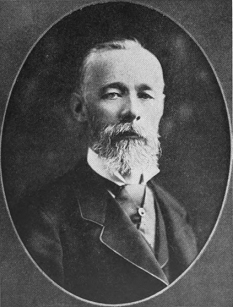
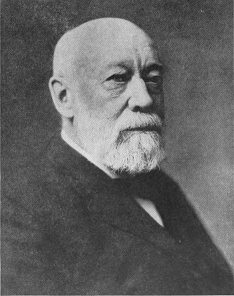
| Introduction | Historical Background | Chronology | Geography | Biography | Technology | Ownership and Financing | General Bibliography |
| Technology | Filtration | Jewell Filter Company |
 |
 |
| Isaiah Smith Hyatt (1835-1885) | John Wesley Hyatt (1837-1920) |
| From The quest for pure water; the history of water purification from the earliest records to the twentieth century by Moses Nelson Baker , Pages 182, 184 (1948) | |
Patrick Clark was appointed engineer of the Rahway water board in May, 1878, where the water works plant pumped water from the north branch of the Rahway river and left heavy sedimentation in the plant and distribution piping. Clark installed a filter in December 1879 that solved the problem, and the following June he obtained a patent for a process of cleaning filter beds.
John Wesley Hyatt, Patrick Clark and Albert Westervelt incorporated the Newark Filtering Company on December 30, 1880 in New Jersey. Hyatt was a prolific inventor who held more than 200 patents, of which about 50 were related to water filters.
Hyatt's older brother, Isaiah Smith Hyatt, went to New Orleans in 1883 to test the ability of their filters to clean Mississippi river water. He was unsuccessful, but L. H. Gardner, superintendent of the New Orleans Water Works Company, had studied and experimented with coagulants to clarify water, and suggested to Hyatt that he employ such an agent, which Hyatt had earlier ridiculed.
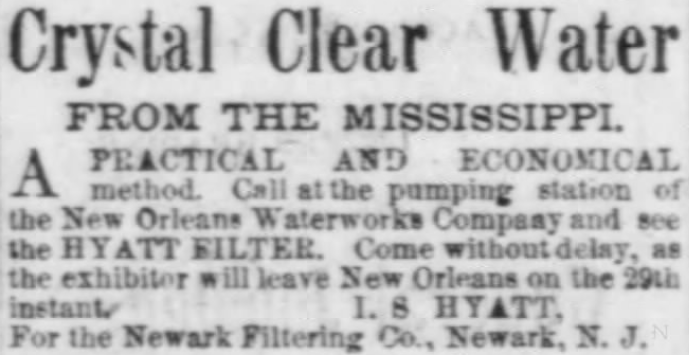 |
| Commercial Bulletin (New Orleans, Louisiana), August 25, 1883, Page 4. |
This proved successful, and Isaiah obtained a patent in February 1884 that employed a broad definition of clarifying agents to be used with the filter.
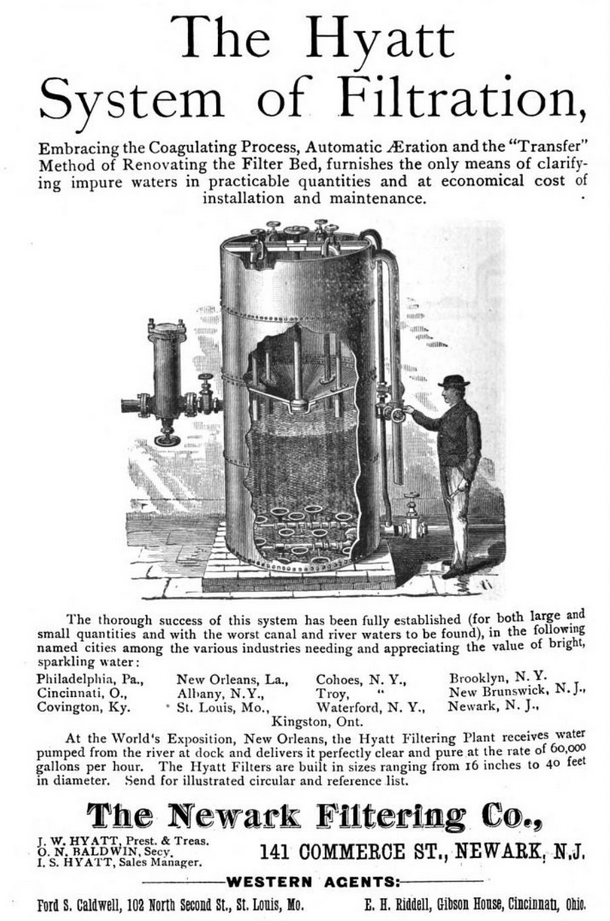 |
| From Statistical Tables of American Water Works, Volume 2, Page 36 (1885) |
The company changed its name to the Hyatt Pure Water Company in 1887.
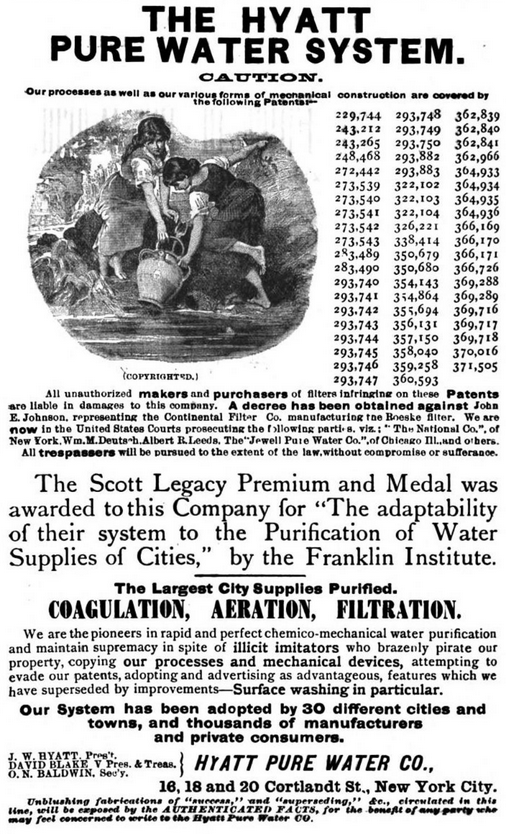 |
| From Manual of American Water Works 1:xxxii, page (1888) |
The New York Filter Company was incorporated in New Jersey on December 5, 1891 with a capital stock of $1,500,000. On February 15th of the following year it was announced that the Hyatt Pure Water Company of Newark, N. J., the National Water Purifying Company of New York city, and the American Filter Company of Chicago, Ill., were consolidated under the corporate name of the New York Filter Company. Shortly thereafter the National Water Purifying Company signed a contract for $134,000 to build a large filter plant for the New Orleans Water Works Company.
 |
| Engineering
News 38:xxxvi (July 7, 1892) |
The New York Filter Company went into receivership in January, 1895 for debts that it was unable to pay due to the failure of the National Water Purifying Company's filters in New Orleans. The company had, however, recently distributed an unearned dividend to its stockholders. The company lost the New Orleans case and was sold and reorganized.
The New York Filter Manufacturing Company was incorporated in New Jersey on May 15, 1896 by Jos. Bushnell, Newark, N.J.; Wm. M. Deutsch, Elizabeth, N.J. Nelson B. Warden, Philadelphia, Pa. Deutsch would gain control of the Continental Filter Company in August, 1898.
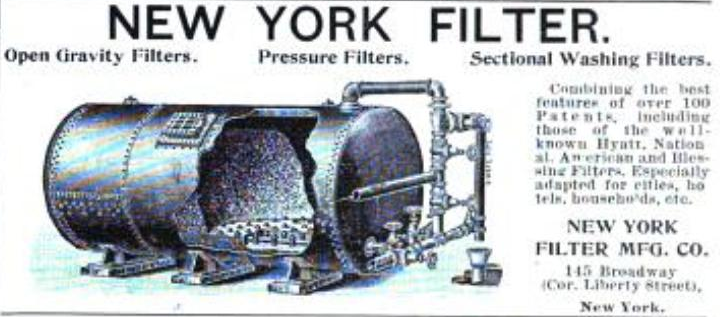 |
| Engineering News 36:xix (July 2, 1896) |
After winning several patent infringement cases against the Jewell filter company, the latter chose to license the Hyatt patents and join forces in March, 1898..
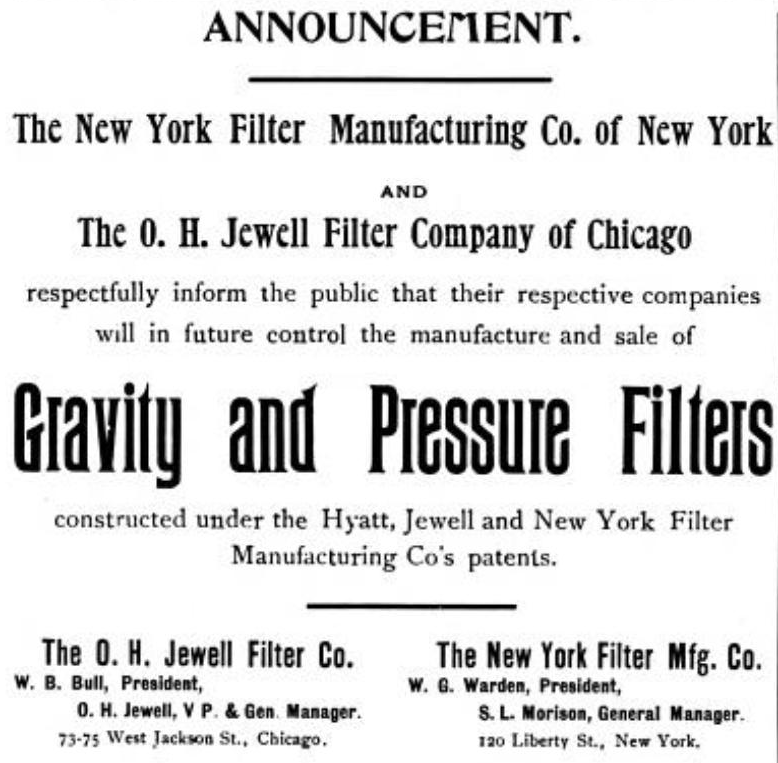 |
| Fire and Water 23:x (March 3, 1898) |
In 1900 the O. H. Jewell Filler Co. and the Continental Filter Co. consolidated with the New York Filter Manufacturing Company to form New York Continental Jewell Filtration Co.
 |
| Fire and Water 28(26):i (December 19, 1909) |
Isaiah Smith Hyatt's 1884 patent would expire in February, 1901, and attempts were made to have Congress pass a bill to allow the term to be extended for ten, and later seven years. This prompted much opposition from water system owners and neither the House nor Senate Patent Committees reported bills to extend the patent, which then expired.
The New York Continental Jewell Filtration Co. was sold at a receiver's sale held at Nutley, N.J., March 26, 1925. The purchaser was the American Water Softener Co., of Philadelphia, through George F. Hodkinson, who for many years was manager of the latter company's filtration department.
Information on the various patent infringement lawsuits can be found on the filtration page.
John Wesley Hyatt Wikipedia page
| Patent Number |
Date |
Patentee(s) | Description |
| U.S. Patent 229,744 | July 6, 1880 | Daniel C. Otis | Filter |
| U.S. Patent 243,212 | June 21, 1881 | Patrick Clark | Process of Cleaning Filtering Beds |
| U.S. Patent 243,265 | June 21, 1881 | John W. Hyatt | Filter |
| U.S. Patent 248,468 | October 18, 1881 | John W. Hyatt | Filter |
| U.S. Patent 272,442 | February 20. 1883 | John W. Hyatt | Filtering Agent |
| U.S. Patent 273,539 | March 6, 1883 | John W. Hyatt | Filter |
| U.S. Patent 273,540 | March 6, 1883 | John W. Hyatt | Filter |
| U.S. Patent 273,541 | March 6, 1883 | John W. Hyatt | Filter |
| U.S. Patent 273,542 | March 6, 1883 | John W. Hyatt | Filter |
| U.S. Patent 273,543 | March 6, 1883 | John W. Hyatt | Filter |
| U.S. Patent 283.489 | August 21, 1883 | John W. Hyatt | Filtering Agent |
| U.S. Patent 283,490 | August 21, 1883 | John W. Hyatt | Differential Pressure Gage |
| U.S. Patent 293,740 | February 19, 1884 | Isaiah Smith Hyatt | Method of Purifying Water |
| U.S. Patent 293.741 | February 19, 1884 | Isaiah Smith Hyatt | Filtering Material |
| U.S. Patent 293,742 | February 19, 1884 | John W. Hyatt | Filter |
| U.S. Patent 293,743 | February 19, 1884 | John W. Hyatt | Filter |
| U.S. Patent 293,744 | February 19, 1884 | John W. Hyatt | Filter |
| U.S. Patent 293,745 | February 19, 1884 | John W. Hyatt | Filter |
| U.S. Patent 293,746 | February 19, 1884 | John W. Hyatt | Filter |
| U.S. Patent 293,747 | February 19, 1884 | John W. Hyatt | Art of Filtration |
| U.S. Patent 293,748 | February 19, 1884 | John W. Hyatt | Art of Filtration |
| U.S. Patent 293,749 | February 19, 1884 | John W. Hyatt | Art of Filtration |
| U.S. Patent 293,750 | February 19, 1884 | John W. Hyatt | Apparatus for Filtering |
| U.S. Patent 293,882 | February 19, 1884 | John W. Hyatt | Art of Filtering Water |
| U.S. Patent 293,883 | February 19, 1884 | John W. Hyatt | Art of Filtering Water |
| U.S. Patent 322,102 | July 14. 1885 | John W. Hyatt | Filtering Apparatus |
| U.S. Patent 322,103 | July 14. 1885 | John W. Hyatt | Filter |
| U.S. Patent 322,104 | July 14. 1885 | John W. Hyatt | Apparatus for Purifying Water |
| U.S. Patent 326,221 | September 15, 1885 | John W. Hyatt | Art of Purifying Water |
| U.S. Patent 338,414 | March 23, 1886 | John W. Hyatt | Filter |
| U.S. Patent 350,679 | October 10, 1886 | John W. Hyatt | Apparatus for Purifying Water |
| U.S. Patent 350,680 | October 10, 1886 | John W. Hyatt | Coagulant for Purifying Water |
| U.S. Patent 354,143 | December 14, 1886 | John W. Hyatt | Filter |
| U.S. Patent 354,864 | December 21, 1886 | John W. Hyatt | Water Cleaner for Boilers |
| U.S. Patent 355,694 | January 11, 1887 | John W. Hyatt | Filter |
| U.S. Patent 356,131 | January 18, 1887 | John W. Hyatt | Steam Boiler Filter |
| U.S. Patent 357,150 | February 1, 1887 | John W. Hyatt | Agitating Filter Beds in Sections |
| U.S. Patent 358,040 | February 22, 1887 | John W. Hyatt | Filter |
| U.S. Patent 359,258 | March 13, 1887 | John W. Hyatt | Cleansing Filter Beds in Sections |
| U.S. Patent 360,593 | April 5, 1887 | John W. Hyatt | Aeration in Aqueducts |
| U.S. Patent 362,839 | May 10, 1887 | John W. Hyatt | Apparatus for Purifying Filter Beds |
| U.S. Patent 362,840 | May 10, 1887 | John W. Hyatt | Boiler Feeder and Purifier |
| U.S. Patent 362,841 | May 10, 1887 | John W. Hyatt | Water Cleaner for Boilers |
| U.S. Patent 362,966 | May 17, 1887 | John W. Hyatt | Coagulant Feeder |
| U.S. Patent 364,933 | June 14, 1887 | John W. Hyatt | Apparatus for Cleansing Filtering Surfaces |
| U.S. Patent 364,934 | June 14, 1887 | John W. Hyatt | Filter Construction and Screen |
| U.S. Patent 364,935 | June 14, 1887 | John W. Hyatt | Means for Cleansing Filter Diaphragms |
| U.S. Patent 364,936 | June 14, 1887 | John W. Hyatt | Abrasion of Filter Diaphragms |
| U.S. Patent 366,169 | July 5, 1887 | John W. Hyatt | Injector for Aeration of Water |
| U.S. Patent 366,170 | July 5, 1887 | John W. Hyatt | Apparatus for Purifying the Water in Steam Boilers |
| U.S. Patent 366,171 | July 5, 1887 | John W. Hyatt | Apparatus for Purifying Water |
| U.S. Patent 366,726 | July 19, 1887 | John W. Hyatt | Agitating Filter Diaphragms with Abrading Material for Cleaning Their Surfaces |
| U.S. Patent 369,288 | August 30, 1887 | John W. Hyatt | Process of Purifying Water |
| U.S. Patent 369,289 | August 30, 1887 | John W. Hyatt | Pump |
| U.S. Patent 369,716 | September 13, 1887 | John W. Hyatt | Filtering Medium |
| U.S. Patent 369,717 | September 13, 1887 | John W. Hyatt | Filtering Substance |
| U.S. Patent 369,718 | September 13, 1887 | John W. Hyatt | Cement Filter |
| U.S. Patent 370,016 | September 13, 1887 | John W. Hyatt | Aeration of Water in Reservoirs |
| U.S. Patent 371,505 | October 11, 1887 | John W. Hyatt | Reducing Valve |
References
1879 Rahway Weekly Advocate
and Times, December 20, 1879, Page 2.
Our ingenious townsman, P. Clark, Esq., has constructed a water filter,
one of which he has introduced into the City Water Works, which is a great
improvement on any heretofore made. Most persons who have employed a
filter for domestic use, have found its value lessened by the deposition
of sedimentary matter on its inner surface. Unless frequently cleansed the
filter becomes clogged or the silt, unable otherwise to escape, is forced
through the filter, thus destroying the value of the appliance. For
these reasons many persons have discontinued the use of such articles
entirely, and prefer accepting the water in its natural state to the care
and trouble of keeping a filter in good working order.
Tho improvements made by Mr. Clark obviate all the above-mentioned
objections. His new filter clears itself of all impurities, as it
separates them from the water. By an ingenious arrangement the silt and
sediment which accumulate in ordinary filter», are carried away by a
separate flow of water, and thus tho instrument never becomes foul and
cannot become clogged. We believe Mr. Clark thinks of securing a patent
for his filter, though he proposes to allow the city tho free use of its
advantages, having, as we said, already introduced one into our Water
Works, at which place he would be pleased to explain its workings to any
one interested in such matters.
1880 Rahway Weekly
Advocate and Times, November 13, 1880, Page 3.
We are informed that a patent has been granted to our townsman, Patrick
Clark, Esq., for an improvement in filters similar to the one built by him
for our Water Works about sixteen months ago, and which during that time
has furnished the city with unobjectionable water. The improvement
being fundamental is considered valuable by by those who are competent
judges. [Clark had filed an application for a patent on October 18,
1880, which was granted the following June.]
1880 Newark Filtering Company incorporated December 30, 1880, capital stock $300,000
1881 "Water,"
by Patrick Clark, Rahway Weekly Advocate and Times, May 7, 1881,
Page 1.
It's various relations to animal and vegetable life, and especially to
mankind when living in large numbers on limited areas of the Earth's
surface.
The writer took charge of the Rahway water-works on the first of June,
1879. The pumping station is on the north branch of the Rahway river,
which furnishes a minimum supply of ten million gallons of water every
twenty-four hours. The works have no reservoir or stand pipe, but pump
directly against the mains. Two duplex compound engines are used
alternately month about each engine being capable of pumping one and
one-half millions every twenty-four hours. The daily consumption of
the city is about five hundred thousand, but the amount for short periods
occasionally runs up to on million gallons. The water remaining in the
reserve pumps and mains always became grossly offensive at the end of
three or four days after the stoppage of the pumps. In June, 1880, a sand
filter was placed between the works and the river. The result was that the
water remaining in the idle pumps and mains at the end of a month was
sweet and palatable.
1881 "Water," by Patrick Clark of Rahway N.J., Morning Journal and Courier (New Haven, Connecticut), May 13, 1881, Page 1. | also here |
1882 "The
Water-Supply of Certain Cities and Towns of the United States," by
Walter G. Elliot, C. E., Ph. D., June 1, 1882, Special Agent, from Statistics
of power and machinery employed in manufactures: reports on the
water-power of the United States, Part 2, by W. P. Trowbridge, Chief
Special Agent, United States. Census Office. 10th census, 1880 (1887).
Page 226: New Jersey. Rahway: Filtering apparatus: Clark
filter, 16 feet square; sand, 6 inches deep, on fine-wire cloth; cleaned
once in 24 hours. 1882 History
of Union and Middlesex Counties, New Jersey: With Biographical
Sketches of Many of Their Pioneers and Prominent Men, by W.
Woodford Clayton
Page 253: The water is filtered by an improved filter (a very
ingenious contrivance), invented by Patrick Clark, engineer of the Rahway
gas-works.
1884 History
of Essex and Hudson Counties, New Jersey, Volume 1
Pages 618-619: Newark Filtering Company and biography of John W.
Hyatt
Newark Filtering Company was chartered in December, 1880, with J. W.
Hyatt, A. C. Westervelt and Patrick Clark as incorporators. These, with
Orrin N. Baldwin, were the first directors. The business of manufacturing
and setting the Hyatt filter is carried on at 141 Commerce Street. The
directors in 1884 were J. W. Hyatt, A. C. Westervelt, Patrick Clark, O. N.
Baldwin, J. S. Hyatt, John D. Harrison and Peter Kinnear, with J. W.
Hyatt, president and treasurer; O. N. Baldwin, secretary.
1885 "The
Clarification and Purification of Public Water Supply," by L.H.
Gardner, Supt. Water Works, New Orleans, Scientific American
Supplement 20(510):1846-8147 (October 10, 1885)
In 1883, Mr. I. S. Hyatt, of Newark, N. J., visited New Orleans with a
filter, the principal and must valuable feature of which was a
self-cleansing device. The courtesies, privileges, and facilities of the
yards and works of the New Orleans Water Works Company were extended to
him for some four months. During that time he experimented on an extended
scale with every known filtering medium or material, and utterly failed in
the filtration of Mississippi River water in such a manner as to deliver
continuously a colorless water. Meantime I was experimenting with lime,
alum, and the various salts of iron, with a view to reservoir
clarification. These experiments were the subject of his pleasant
ridicule. Toward the close of his stay in New Orleans, I prevailed upon
him, in his disappointment, to try a precipitating agent or coagulant in
the water previous to its introduction into his filter. He experimented in
this direction, succeeded, and I believe obtained a patent upon the
combination. Several of the Newark filters embodying this feature are in
use in manufacturing establishments in and about New Orleans.
1886 Water Purification by the Hyatt System, June 1886, by Newark Filtering Company | pdf |
1886 "The Hyatt Pure Water System," advertisement, The Sanitary Era 1:2 (July 31, 1886)
1887 Morning
Journal and Courier (New Haven, Connecticut), March 7, 1887,
Page 2.
Died at Rahway, New Jersey, On Saturday, March 5, of pneumonia, Patrick
Clark, in the eightieth year of his age. Newark Filtering Company.
1887 Newark Filtering Company name changed to Hyatt Pure Water Company, May 23; 1887
1887 "Hyatt Pure Water System," advertisement, The Sanitary Era 1(330):335 (August 1, 1887)
1887 Descriptive Circular of the Hyatt Pure Water System
1888 "United
States Circuit Court - New Suits," Chicago Tribune, August
14, 1888, Page 8.
Hyatt Pure Water Co. vs. Jewell Pure Water Co. Bill to restrain use
of titles, "Jewell Pure Water Company" and "Jewell Pure Water System."
1889 "The
Courts - U.S. Circuit," Chicago Inter Ocean, February 14,
1889, Page 10.
Hyatt Pure Water Co. vs. Jewell Pure Water Co; lv to complts to dis c c
and case disd.
1891 New York Filter Company incorporated in New Jersey, December 5, 1891, Capital Stock $1,500,000.
1892 "New
York Filter Company," Fire and Water 11(8) (February 20,
1892)
We are in receipt of the following communications which explain
themselves: 145 BROADWAY, NEW YORK, February 15, 1892. DEAR SIR—The Hyatt
Pure Water Company of Newark, N. J., the National Water Purifying Company
of New York city, and the American Filter Company of Chicago, Ill., beg to
announce that they have consolidated under the corporate name of the New
York Filter Company.
1892 Engineering
News 27:167 (February 20, 1892)
The consolidation of the Hyatt Pure Water Co., of Newark. N. J., the
National Water Purifying Co., New York City. and the American Filter Co.,
Chicago, I11., has just been officially announced. The new company has
incorporated under the laws of New Jersey with a capital stock of
$1,500,000, and with the name, the New York Filter Co. The full list of
Directors is as follows: C. C. Worthington. John W. Hyatt, Henry P. Jones.
A. C Westervelt, Peter Kinnear, W. M. Deutsch, Albert R. Leeds, .Theodore
F. Miller and John D. Harrison. The officers are: President, C. C.
Worthington. of the Worthington Pump Co., New York City; Vice-President,
John W. Hyatt, of the Hyatt Pure Water Co., Newark, N. J.; Treasurer.
Henry P- Jones, Newark, N. J.; Secretary, John C. Symons, of the National
Water Purifying Co.. New York City. The new company acquires all the
patents, about one hundred in number, of the old companies. Its office is
at 145 Broadway, New York City.
1892 "Trade
Publications," Engineering News 27:506 (May 19, 1892)
Mechanical Filters - New York Filter Co., New York; oblong, pp. 85.
This pamphlet describes and illustrates in detail the filters heretofore
made by the Hyatt Pure Water Co., United States Water Supply Co., National
Water Purifying Co. and American Filter co. These companies were
recently consolidated as the New York Filter Co. Prices for various
sized filters of the different types are given and many testimonials from
individuals, manufacturing firms and water-works officials having the
filters in use. [Note: no copy of this has been found.]
1893 New York Filter Co.: capital $1,500,000, owning the patents (over one hundred in number) of Hyatt Pure Water Co., U.S. Pure Water Supply Co., National Water Purifying Co. June 1, 1893.
1894 Albert C. Westervelt (1832-1894) grave. Incorporator of the Newark Filtering Company in 1880.
1895 "A
Final Decision on a Mechanical Filtration Patent," Engineering
News 33:44-45 (January 17, 1895)
Involves use of alum or other coagulant.
1895 "Attachment Against the Filter Trust," The Sun (New York, New York), January 24, 1895, Page 5.
1895 "Big
Filter Company in Trouble," The Inter Ocean, January 31,
1895, Page 2.
Receiver appointed for New York Filter Company
1895 New
York Tribune, November 19, 1895, Page 8.
John R. Hardin, receiver of the New-York Filter Company has received
information that the courts in Louisiana have rendered a decision against
the company.
1896 New York Filter Manufacturing Company incorporated in New Jersey, May 15, 1896, capital stock $600,000
1896 "New
Companies," Engineering News Supplement 35:176 (May 28,
1896)
New York Filter Mfg. Co., Newark, N.J.; $600,000; Jos. Bushnell, Newark,
N.J.; Wm. M. Deutsch, Elizabeth, N.J.; Nelson B. Warden, Philadelphia, Pa.
1896 Engineering
News Supplement 36:21 (July 16, 1896)
The New York Filter Manufacturing Company, 145 Broadway, New York city,
has been organized to succeed the New York Filter Co. The new
company will control all the patents held by the old one, known as the
Hyatt, United States, National, American, and Blessing, and including the
Hyatt patent No. 293,740, of Feb. 19, 1884. The company announces
that it proposes to prosecute all infringers of its patents, past and
future.
1897 New York Filtering Company, September 1897
1898 Engineering
News 39:37 (March 3, 1898)
The Consolidation of Two Mechanical Filter companies after several years
of bitter conflict, as noted from time to time in this journal, has been
effected as set forth in the following official statement:
Within the past few days, and as the result of the long and successful
litigation of the New York Filter Manufacturing Co. against the Jewell
filter, the O. H. Jewell Filter Co., of Chicago, Ill., has made settlement
for its past infringements and taken a license under the Hyatt patent, by
the terms of which it becomes the exclusive licensee under the Hyatt
patent for all territory west of Pennsylvania, north of the Ohio River and
west of the Mississippi River, including Tennessee and Kentucky. Hereafter
the New York Filter Manufacturing Co. will confine its business to the
eastern territory, and within that territory will supply the Jewell
filter. The Morison-Jewell Filtration Co., of New York and Philadelphia,
has likewise made a settlement, and is to retire from business. The New
York Filter Manufacturing Co. has elected as its President, Mr. W. G.
Warden, of Philadelphia, and as General Manager, Mr. Samuel L. Morison,
heretofore Vice-President and General Manager of the Morison-Jewell
Filtration Co. The emcee of the company will continue for the present to
be located at 120 Liberty St., New York city.
In the some connection it may be noted that the Loomis filter,
manufactured by the Loomis-Manning Filter Co., of Philadelphia, has been
declared to be an infringement on the Hyatt patent, in so far as the use
of alum is concerned. This declaration was made on Feb. 26, in connection
with a preliminary injunction granted by Judge Lacombe of the United
States Circuit Court for the Southern District of New York.
1898 "Filtration
Companies Agreement," Fire and Water 23:76 (March 3, 1898)
Within the past few days, and as the result of the long and successful
litigation of the New York Filter Manufacturing Company against the Jewell
filter, the O. H. Jewell Filter Company of Chicago, Ill., has made
settlement for its past infringements and taken a license under the Hyatt
patent, by the terms of which it becomes the exclusive licensee under the
Hyatt patent for all territory west of Pennsylvania, north of the Ohio
river and west of the Mississippi river, including Tennessee and Kentucky.
Hereafter, the New York Filter Manufacturing Company will confine its
business to the eastern territory, and within that territory will supply
the Jewell filter. The Morison-Jewell Filtration Company, of New York and
Philadelphia, has likewise made a settlement, and is to retire from
business. The New York Filter Manufacturing Company has elected as its
president, Mr. W. G. Warden, and as general manager, Mr. Samuel L.
Morison, heretofore vice-president and general manager of the
Morison-Jewell Filtration Company.
1898 "Announcement,"
advertisement, Fire and Water 23:x (March 3, 1898)
The New York Filter Manufacturing Co. of New York and the O.H. Jewell
Filter Company of Chicago respectfully inform the public that their
respective companies will in future control the manufacture and sale of
Gravity and Pressure Filters constructed under the Hyatt, Jewell and New
York Filter Manufacturing Co's Patents.
1898 New
York Tribune, March 4, 1898, Page 3.
After long and successful litigation, the New-York Filter Manufacturing
Company has compelled the O. H. Jewell Filter Company, of Chicago, to take
out licenses under the Hyatt patent. An amicable arrangement has
been made by which the former corporation confines its operation to
Eastern territory, and the laater to a part of the West. The
Morrison Filter Company retires from business, and its head becomes a
vice-president in the New-York company. Meanwhile, the
Loomis-Manning filter, of Philadelphia, has been found guilty of
infringing the Hyatt patents, as least in so far as alum is used in their
products.
1910 Colonel Livingston Hall Gardner Sr (1836-1910), grave. Superintendent of New Orleans Water Works Company.
1910 "L. H. Gardner, Dead," Fire and Water Engineering 48:386 (December 7, 1910)
1939 "New Jersey Birthplace of the Filter," by M. N. Baker. Engineering News-Record 122:777 (June 8, 1939)
1948 The
quest for pure water; the history of water purification from the
earliest records to the twentieth century, by Moses
Nelson Baker
Chapter VII. Inception and Widespread Adoption of Rapid Filtration in
America includes substantial information on Hyatt filters | pdf
with references |
© 2020 Morris A. Pierce